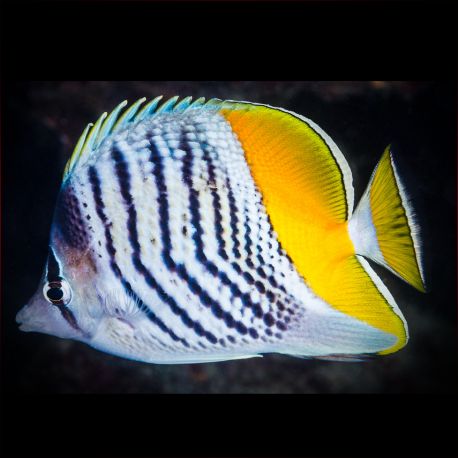More info
Datasheet
| Minimum Tank Size | 300 litres / 79.25 US gallons |
| Maximum Size | 13.0cm / 5.12inches |
| Reef Compatible | Not reef safe |
| Temperament | Mostly peaceful but might be aggressive towards similar species |
| Temperature | 22.2°C / 71.96°F - 25.6°C / 78.08°F |
| Specific Gravity | 1.020-1.025 |
| Carbonate Hardness | 8-12 |
| pH | 8.1-8.4 |
General Description:The Seychelles Butterflyfish, scientifically known as Chaetodon mertensii, is part of the Chaetodontidae family, characterized by their vibrant colors and striking patterns. These fish are often found in groups known as "complexes," with slight variations distinguishing each species, making it crucial to identify them accurately.
Aquarium Suitability:Considered suitable with care, the Seychelles Butterflyfish is a hardy species that thrives in well-established aquariums with ample space for swimming. They require a varied diet consisting of macroalgae, microalgae, small crustaceans, and zooplankton, feeding multiple times a day, particularly when newly introduced. It is advised to keep them away from aggressive tankmates and provide adequate hiding spots among live rocks.
Demands:This species requires feeding several times a day and must have access to their natural diet components, such as live SPS and LPS corals. They tend to thrive better when kept as the sole representative of their species in the aquarium and are known to be shy and docile, making compatibility with aggressive fish a concern.
Care and Hardiness:The Seychelles Butterflyfish are generally hardy and adaptable to a range of water conditions with a temperature of 22.2-25.6°C, pH levels of 8.1-8.4, and specific gravity between 1.020-1.025. They benefit from a well-maintained environment where they can graze on algae-rich surfaces, supplementing their diet with Spirulina and other suitable foods.
Reef Suitability:This particular species is not reef-safe and may pose a threat to clam species and other invertebrates in a reef setup. Their tendency to nibble at clams, including Tridacna species, alongside their preference for tubeworms, makes them unsuitable for a traditional reef tank environment.
Aquarium Setup:When setting up an aquarium for Seychelles Butterflyfish, ensure plentiful hiding spaces amidst live rocks, a well-run system with algae for grazing, and a sufficiently large tank of at least 300 liters. Maintaining consistent water parameters within the recommended ranges is crucial for the health and well-being of these fish.
Behaviour:Being mostly peaceful, the Seychelles Butterflyfish may exhibit aggression towards similar species, highlighting the importance of cautious tankmate selection. Their social behavior allows for cohabitation with multiple Butterflyfish, preferably in pairs, but close attention must be paid to individual interactions and potential conflicts.
Feeding and Diet:With a diet consisting of large polyp stone coral (LPS), small polyp stone coral (SPS), and soft coral, these fish require a varied intake of foods such as macroalgae, microalgae, small crustaceans, and zooplankton. Ensuring a nutritionally balanced diet is key to their overall health and vitality.
Dimorphism:While dimorphism details are not explicitly outlined, captive reproduction may be achievable with certain species of Butterflyfish, allowing for the provision of frozen foods as an alternative diet source. Ensuring the viability of captive reproduction and successful breeding may involve meticulous observation and care.
Habitat and Distribution:The Seychelles Butterflyfish can be found in the Pacific Ocean, ranging from the Ryukyu Islands to the Philippines and extending to various other islands. Their distribution is limited by other species such as Chaetodon madagascariensis, Chaetodon xanthurus, and Chaetodon paucifasciatus in distinct regions, emphasizing the species' range and adaptation within specific habitats.

